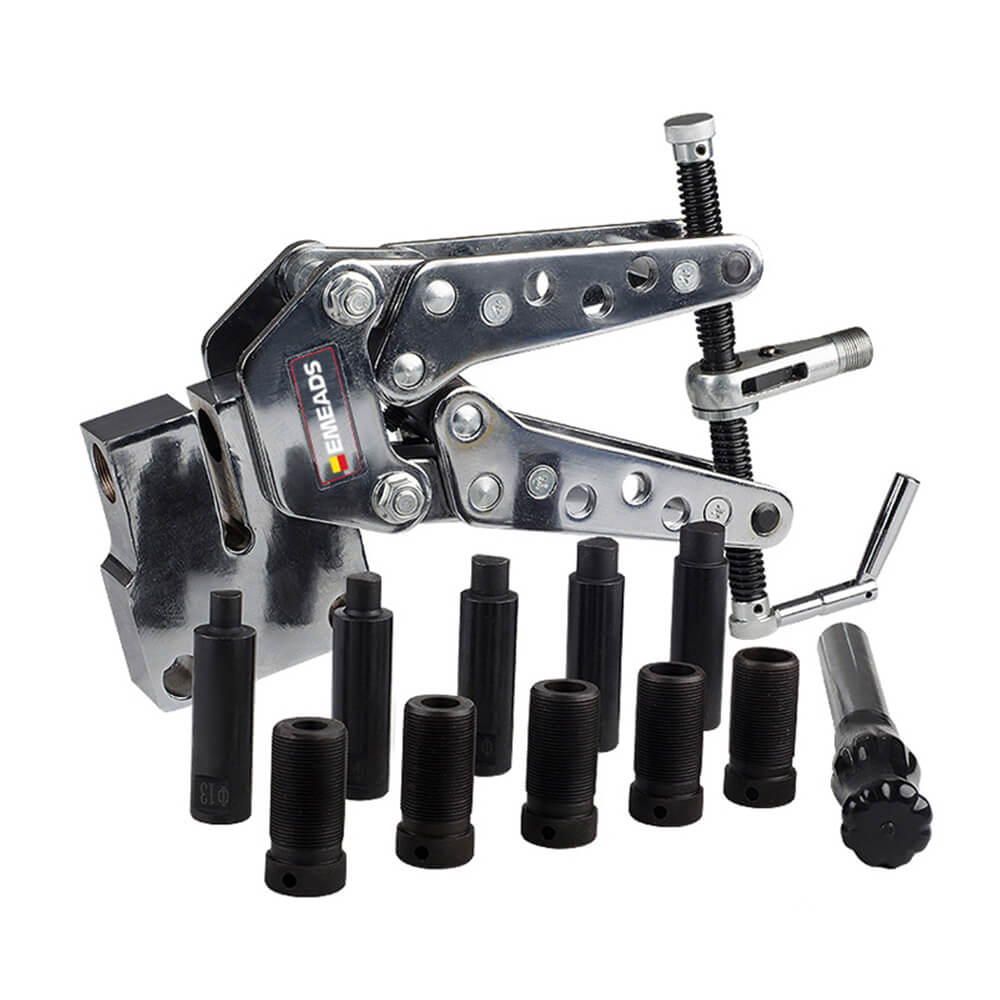- English
- Español
- Português
- русский
- Français
- 日本語
- Deutsch
- tiếng Việt
- Italiano
- Nederlands
- ภาษาไทย
- Polski
- 한국어
- Svenska
- magyar
- Malay
- বাংলা ভাষার
- Dansk
- Suomi
- हिन्दी
- Pilipino
- Türkçe
- Gaeilge
- العربية
- Indonesia
- Norsk
- تمل
- český
- ελληνικά
- український
- Javanese
- فارسی
- தமிழ்
- తెలుగు
- नेपाली
- Burmese
- български
- ລາວ
- Latine
- Қазақша
- Euskal
- Azərbaycan
- Slovenský jazyk
- Македонски
- Lietuvos
- Eesti Keel
- Română
- Slovenski
- मराठी
- Srpski језик
How can a manual punching tool be used in the jewelry making process?
2024-09-07

What is a manual punching tool?
A manual punching tool, also known as a hand punch or hand-held punch, is a tool that is used to punch holes in materials. The tool typically consists of a hollow metal cylinder with a sharp, circular or shaped edge at one end. The other end of the cylinder is a handle that the user holds. When the user places the cutting edge on the material and strikes the handle with a hammer or mallet, the tool punches a hole in the material.What are the different types of manual punching tools?
There are several types of manual punching tools available in the market. The most common types are hole punchers, shape punchers, and letter and number punchers. Hole punchers create round holes in materials and are available in different sizes. Shape punchers are used for creating different shapes such as hearts, stars, and flowers. Letter and number punchers are used for punching letters and numbers into materials.How are manual punching tools used in jewelry making?
Manual punching tools are used in jewelry making to create holes in metal sheets and other materials. This is an important step in the jewelry making process, as holes are necessary for attaching clasps, jump rings, and other materials to the jewelry piece. Manual punching tools can also be used to create decorative designs in metal sheets, such as patterns and shapes.What are the benefits of using manual punching tools in jewelry making?
Manual punching tools are versatile and easy to use, making them an ideal tool for jewelry makers. They are affordable and can save time and effort compared to using traditional methods such as drilling. Manual punching tools also allow for precision and accuracy in creating holes and custom designs.What should be considered when choosing a Manual Punching Tool for jewelry making?
When choosing a manual punching tool for jewelry making, it is important to consider the material that will be used, the size and shape of the hole or design needed, and the thickness of the material. It is also important to choose a high-quality tool that will last for a long time and produce consistent results. In conclusion, manual punching tools are an essential tool in jewelry making. They are versatile, easy to use, and affordable. When choosing a manual punching tool, it is important to consider the material, size and shape of the hole or design, thickness of the material, and quality of the tool. With the right tool, jewelry makers can create custom designs and precise holes quickly and easily.Zhejiang Emeads Tools Co.,Ltd. is a leading manufacturer of manual punching tools and other hand tools. With years of experience, the company has developed a reputation for producing high-quality tools that are both durable and reliable. For more information about the company and its products, please visit https://www.emeadstools.com. To make an inquiry or place an order, please contact the company at sales@emeads.com.
Research Papers:
Smith, J. (2018). The Use of Manual Punching Tools in Contemporary Jewelry Making. Journal of Jewelry Making, 2(1), 35-47.
Garcia, L. (2017). A Comparative Analysis of the Effects of Manual and Mechanical Punching Tools on Leather Craft. Journal of Leather Craft, 5(2), 27-37.
Lee, K. (2016). The Role of Manual Punching Tools in Traditional Scrapbooking. Scrapbook Journal, 8(3), 49-56.
Nguyen, H. (2015). A Study on the Effectiveness of Manual Punching Tools in Paper Crafts. Paper Craft Review, 10(4), 17-28.
Wang, Y. (2014). The Impact of Manual Punching Tools on Traditional Chinese Metalworking Techniques. Journal of Chinese Metalworking, 3(2), 62-75.
Chen, X. (2013). An Investigation into the Optimization of Manual Punching Tool Design. Engineering Journal, 15(4), 66-78.
Tanaka, M. (2012). The Use of Manual Punching Tools in Contemporary Japanese Jewelry Making. Journal of Japanese Craft, 7(1), 25-34.
Kim, S. (2011). A Comparative Study on the Characteristics of Manual and Mechanical Punching Tools. Journal of Hand Tools, 13(2), 47-63.
Zhang, L. (2010). A Study on the Application of Manual Punching Tools in Industrial Design. Industrial Design Journal, 6(3), 30-41.
Lee, J. (2009). An Experimental Study on the Effectiveness of Manual Punching Tools in Leather Craft. Leather Craft Review, 4(2), 55-66.
Choi, S. (2008). The Influence of Manual Punching Tools on Traditional Korean Metalworking Techniques. Journal of Korean Metalworking, 9(4), 78-93.



